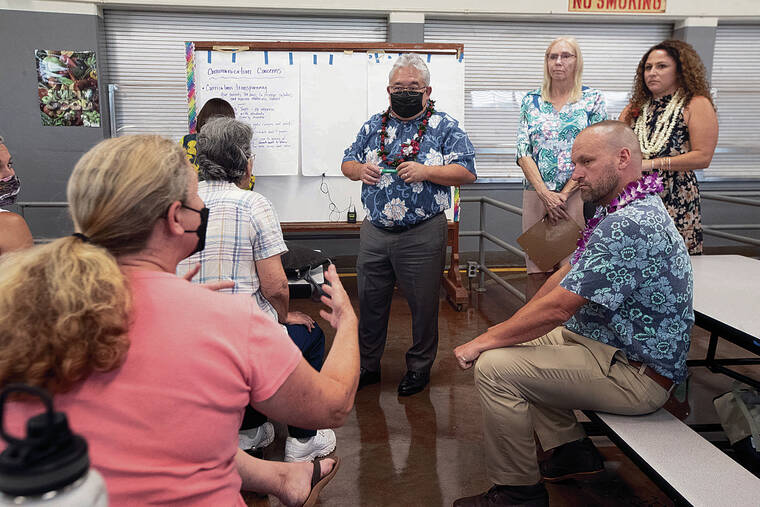The difficulty that parents often encounter in reaching Hawaii public school officials, testifying at weekday state Board of Education meetings and getting confirmation that their concerns are being carefully considered were among the complaints voiced by some of the nearly 80 people who attended the first community forum held by the board since the pandemic began.
The forum, which was organized to focus on defining problems in communication between schools and parents, and finding solutions, drew a mix of parents and family members, students, community members and board and state Department of Education staff members July 29 to the Pearl City Highlands Elementary School cafeteria.
The meeting was called by the board following recent verbal clashes with people opposed to masking and some other recent COVID-19 measures in the public schools.
Jessica Priya Caiazzo, a state House candidate who describes herself as an independent advocate for some parents, said their experience of having stacks of
letters, emails and messages go unanswered by board and department officials has made them feel “marginalized and oppressed.”
Marissa Baptista, a mother of three public school students in the Salt Lake area, told DOE officials, “You need to push more information out, instead of us always having to pull.”
BOE Chair Bruce Voss later said, “I agree 100%” with Baptista’s remark. “Parents feel the burden of communication is on them.”
The board is required by statute to hold six community forums a year, with at least one forum in each county. But the community
forums fell off schedule in the pandemic as board meetings went virtual.
Voss said conversations with Caiazzo led to the board’s restarting its required series of community forums with a meeting focused on improving communication. He added that he was impressed at the lengths some people went through — driving in from the farthest reaches of the Waianae Coast, for instance — in order to attend.
The community forum was different from a regular board meeting: After brief opening speeches, attendees broke into small working groups of about a dozen each, and DOE officials and board members led each group’s discussions, focused on the single issue of communication. Complaints, and suggestions for improvement, were discussed and written on large papers taped to the wall. The results were reported back to the large group.
Although the discussion volume, intensity and topics varied from one group to the next, common themes included parents’ desire to have more of a voice in BOE meetings and policymaking, and to see a shift in board procedures so that more meetings could be held at nights and on weekends, when parents and teachers may be more available to attend and testify.
Several attendees mentioned they wanted to be able to view and give
feedback on curriculum taught to their children. Some parents seized the moment to tell state schools Superintendent Keith Hayashi about their worries about classroom air quality, while others told him they hoped the schools would stay with the current shift to leaving masking optional.
When the group switched to brainstorming solutions, ideas that Voss said stood out included having school websites include contacts for faculty and staff; holding more live events at schools where parents can talk with school officials to raise questions and concerns; and allowing parent advocates at school meetings, “kind of like an interpreter.”
A summary of top suggestions for improving school-parent communication that were gleaned from the meeting will be distributed to schools statewide, and discussed at the board’s Aug. 18 meeting, Voss said. They will also help inform the board’s work as it launches into creating the next strategic plan for Hawaii’s 258 public schools.
Additional dates for community forums have not yet been set. The BOE posts meeting notices and agendas on its website. Opens in a new tab

